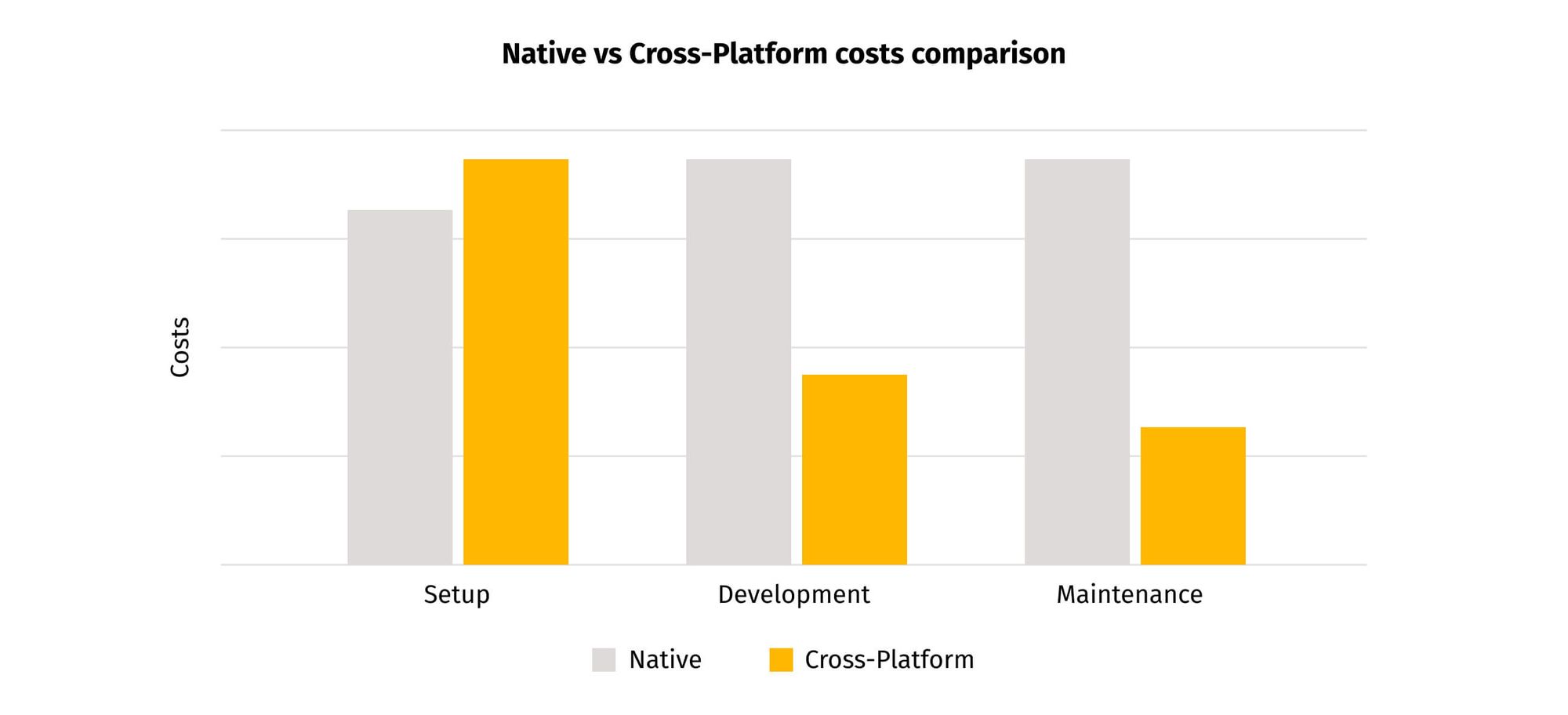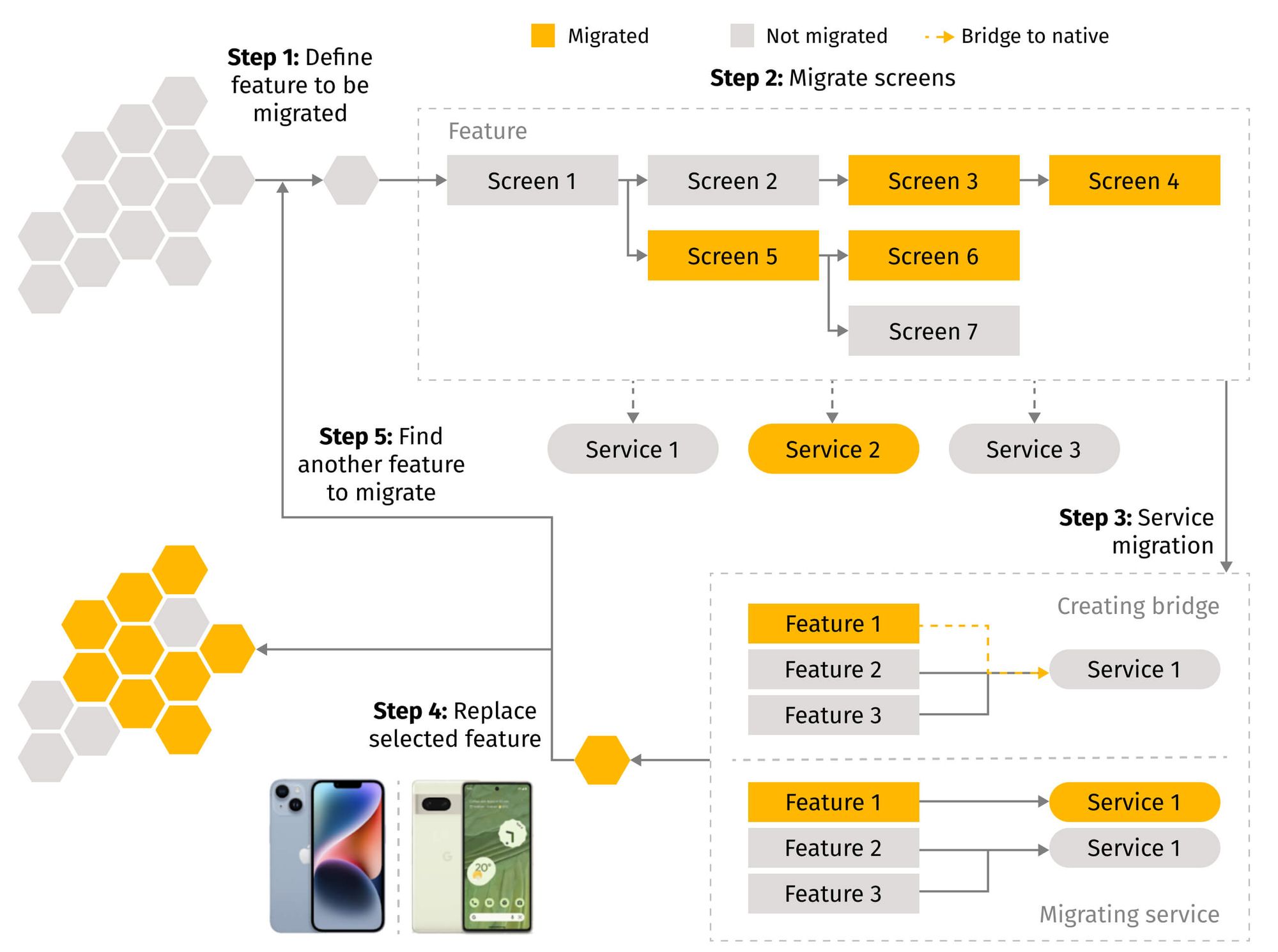
Migrating mobile applications using cross-platform technologies
Cross-platform technologies have revolutionized the way developers create mobile and web applications. These frameworks allow developers to use a single codebase to build applications that run across different devices and platforms instead of writing separate code for each platform. Moreover, each framework contains many readily available tools, making the development process faster and more productive.
In this article, we will discuss the business value of cross-platform app development, how to migrate existing apps without interrupting performance, and why cross-platform migration is a go-to strategy for gaining competitive advantage.
The business value of cross-platform app migration
There are many different cross-platform technologies available, each with their own unique features and benefits. The most popular technologies are Flutter, React Native, Xamarin, Ionic, and Kotlin Multiplatform Mobile (KMM). These frameworks use different programming languages, approaches, and toolsets to build cross-platform apps.
When you consider that the number of smartphone mobile network subscriptions worldwide reached almost 6.6 billion in 2022, and is forecast to exceed 7.8 billion by 2028, coupled with the fact that 92% of mobile users interact with brands primarily through mobile apps and social media in 2023, the demand for cross-platform technologies is growing substantially. With the rise of mobile and web-based applications, businesses need to develop applications that can run on multiple platforms to reach a broader audience. Cross-platform technologies provide a cost-effective solution for businesses to create applications that can run on multiple platforms, without the need for separate codebases for each platform.
In addition, cross-platform technologies have also become increasingly accessible to developers of all skill levels. With the availability of open-source frameworks, developers can quickly and easily create high-quality applications for multiple platforms. This has led to a growing community of developers who are actively contributing to the development of cross-platform technologies.
Migrating native mobile applications to a cross-platform implementation provides several valuable benefits to your application development process. From a business value perspective, they are:
- Increased platform support. If an application is currently available only on a single platform, such as iOS or Android, migration to a cross-platform technology provides opportunities to expand the user base on another platform.
- Single application team. Since a single team maintains cross-platform apps, planning and delivery of features, as well as support, is quicker and more streamlined.
- Synchronized delivery. A single codebase for applications on both platforms, including models, services, and business logic, removes the disparity between Android and iOS. A consistent user experience also helps support and eliminate stubborn bugs that occur on one platform only.
- Faster time-to-market. Cross-platform frameworks offer a number of components and libraries that can speed up development, reducing the time and effort required to deliver a new feature to an app.
- Branded UI across apps and websites. UI components can be shared between a cross-platform application and a web page. So your website and mobile applications will have a pretty similar UI without extra effort.
- Faster tech onboarding for developers. Since cross-platform technologies are simpler to use and more intuitive than native technologies, newcomers will be onboarded and become familiar with technical aspects faster and easier.
- Quick temporary promotional tweaks. Cross-platform technologies enable the integration of temporary or seasonal features across platforms. This saves time and effort that would otherwise be spent on implementing native UI, updating, testing, and integrating business logic.
Cost optimization
Cost optimization is one of the main benefits and targets of migration to cross-platform.
Using technologies such as KMM, React Native, and Flutter to develop a single shared codebase for both Android and iOS allows for optimization and reduction of:
- Development costs; and
- Maintenance costs.
Development cost reduction varies between stages. At the beginning of the integration and adaptation of a cross-platform codebase into a native one, the difference might not be significant. However, later on, when adding new features using a streamlined process, development time, and ultimately, cost, decreases. Since fewer development and managerial efforts will be required, projects will also benefit from more streamlined communication and synchronization.
Maintenance of cross-platform projects often yields a significant improvement in cost efficiency. From our working experience, by utilizing a single team for the upkeep of the entire codebase, companies can experience up to a 50% reduction in product support expenses.
In addition to this short-term value, the real advantages of opting for a cross-platform solution become more evident over an extended period of time. Figure 2 demonstrates a relative comparison of spend on native vs. cross-platform app development over software development lifecycle (SDLC) stages, as gathered from our experience working with both technologies.

Migration process
In a previous blog post, Easily move your native app to Flutter, we discussed a migration from native to cross-platform implementation using Flutter. Since 2019, however, Flutter and cross-platform technologies have been significantly updated. You can now migrate native applications, and reap all the benefits provided by cross-platform technologies with greater ease.
Application migration is a process of rewriting an existing native application to a cross-platform technology. During migration, you take a feature and reimplement its UI, business logic, and data management to cross-platform technologies. After the feature is reimplemented, you integrate it into your native applications (as shown in Figure 2).
Such a feature-by-feature migration prevents disruptions to user experience in the application, and removes the need to support apps for native Android, iOS, and cross-platform at the same time.

Step-by-step feature migration strategy
One of the benefits of cross-platform development lies in the ability to expedite the implementation and integration of features across both Android and iOS platforms. A single codebase allows code to be written once and used on both platforms. To migrate efficiently, we recommend a feature-by-feature migration.
An application сan be described as a set of features. Since some features can be dependent on another feature, the migration should start from ‘self-sufficient’ features that have no internal feature dependencies. We suggest the following features as good first candidates to start the app migration process to a cross-platform tech stack:
- Authentication
- Profile & Settings
- Search & Browse
- Cart & Checkout
- Orders
- Recommendations
- Loyalty Program
- Pick-Up
In addition, cross-platform technologies can also be leveraged to create temporary features that support promotional activities such as holidays, anniversaries, and other seasonal or event-based promotions.
For example, adding one of the following activities to the existing experience:
- A small game;
- Interesting quiz module;
- New UX related to a holiday or promotional event, like Black Friday.
These temporary features can be an effective way for businesses to generate excitement and engagement from customers during specific periods.
This streamlined process can save businesses significant time and resources, enabling them to quickly develop and deploy new features. Additionally, because cross-platform technologies provide a consistent user experience across both platforms, businesses can ensure that their features are available to customers regardless of the device they are using.
Cross-platform technologies across industries
Cross-platform technologies are becoming more and more popular in a variety of business domains. Companies across industries use cross-platform technologies, such as React Native, KMM, and Flutter, to implement applications from scratch or integrate several shared features. Let's take a look at a non-exhaustive list:
- E-commerce: Alibaba, eBay, Shopify, Walmart
- Finance: Nubank, Crédit Agricole, Cash App, Klarna
- Social Media: Facebook, Discord, Microsoft Outlook Teams, Skype
- Healthcare: Phillips, Asmi, Feel, XWalk
- Transportation: Uber, Bolt, Tesla, Skyscanner
Overall, the position of cross-platform technologies on the market is strong, and it is expected to continue to grow in the coming years. In a survey on Cross-platform mobile frameworks used by software developers worldwide from 2019 to 2022, it was discovered that roughly one third of mobile developers now use cross-platform technologies or frameworks. With the demand for applications that can run on multiple platforms, businesses and developers alike will continue to rely on cross-platform technologies to create high-quality applications that can reach a wider audience.
Summary
The usage of cross-platform technologies opens new possibilities, methods, and experiences in mobile application development. Companies can reduce development costs, increase productivity, and improve the overall user experience for their customers. While there may be some challenges in the initial stages of migration, the long-term advantages are well worth the effort. As technology continues to evolve, cross-platform development will become increasingly important for businesses looking to stay competitive. With the ability to create applications that can run on multiple platforms, companies can reach a wider audience and expand their customer base. Moreover, application migration will help you to combine the benefits of cross-platform and native technologies.
To learn more about how Grid Dynamics can help with cross-platform app development and migration, take a look at our Cross-Platform Mobile App Development Services.



